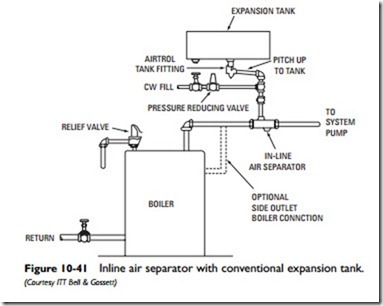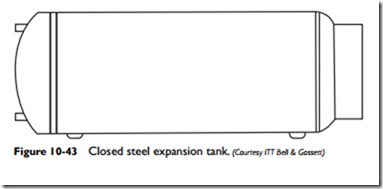Expansion Tanks
Expansion tanks (also sometimes called compression tanks) are installed in hydronic (hot-water) space heating systems to limit increases in pressure to the allowable working pressure of the equipment and to maintain minimum operating pressures.
When the temperatures rise during the operation of the system, the water volume also increases and builds up pressure. The pressure in the system is relieved to a certain extent by the storage of the excess water volume in the expansion tank. When temperatures drop, there is a corresponding drop in water volume and the water returns to the system.
Maximum pressure at the boiler is maintained by an ASME pressure-relief valve. Minimum pressure in the system is generally maintained by either an automatic or manual water-fill valve.
Closed steel expansion tanks and diaphragm tanks are used to contain the expanding volume of heated water in residential and light-commercial hydronic heating systems. Some typical installations using ITT Bell & Gossett expansion tanks are illustrated in Figures 10-40 through 10-42.
Closed Steel Expansion Tanks
The closed steel expansion tank has no moving parts (see Figure 10-43).
It is normally two-thirds filled with water and one-third with air. As heated water expands and its excess volume enters the tank, it compresses the air at the top of the tank. The compression of the air in the tank results in an increase of system pressure, which is indicated on the boiler pressure gauge.
Note
If the expansion tank is properly sized, the pressure increase should be not more than about a pound before the system high-limit temperature is reached.
When the system water cools down, its volume contracts, and the air in the tank expands back to its original volume, causing sys- tem pressure to fall. To sum it all up, the rise and fall of system pressure is created by the expansion and contraction of the air in the expansion tank.
One problem encountered with a closed steel expansion tank directly connected into the system is that the system water can absorb the air and send it to the radiators and convectors by gravity circulation. Installing a gravity-flow check valve on the expansion tank will prevent gravity circulation.



